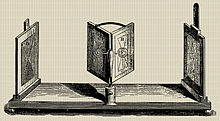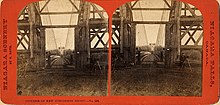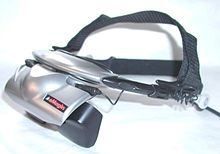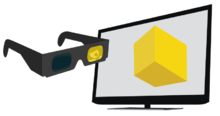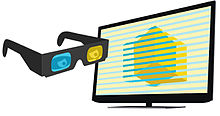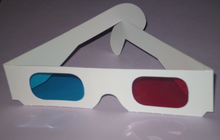From Wikipedia, the free encyclopedia
Pocket stereoscope with original test image. Used by military to examine stereoscopic pairs of
aerial photographs.
View of Boston, c. 1860; an early stereoscopic card for viewing a scene from nature
Stereoscopic image of 787 Orange Street, Addison R. Tinsley house, circa 1890s.
Stereoscopic image of 772 College Street (formerly Johnson Street) in Macon, Ga, circa 1870s.
Kaiserpanorama consists of a multi-station viewing apparatus and sets of stereo slides. Patented by A. Fuhrmann around 1890.
A company of ladies looking at stereoscopic views, painting by
Jacob Spoel, before 1868. An early depiction of people using a stereoscope.
Stereoscopy (also called stereoscopics, or stereo imaging) is a technique for creating or enhancing the illusion of depth in an image by means of stereopsis for binocular vision. The word stereoscopy derives from Greek στερεός (stereos) 'firm, solid', and σκοπέω (skopeō) 'to look, to see'. Any stereoscopic image is called a stereogram. Originally, stereogram referred to a pair of stereo images which could be viewed using a stereoscope.
Most stereoscopic methods present two offset images separately to the left and right eye of the viewer. These two-dimensional images are then combined in the brain to give the perception of 3D depth. This technique is distinguished from 3D displays that display an image in three full dimensions, allowing the observer to increase information about the 3-dimensional objects being displayed by head and eye movements.
Background
Stereoscopy creates the illusion of three-dimensional depth from given two-dimensional images.
Human vision, including the perception of depth, is a complex process,
which only begins with the acquisition of visual information taken in
through the eyes; much processing ensues within the brain, as it strives
to make sense of the raw information. One of the functions that occur
within the brain as it interprets what the eyes see is assessing the
relative distances of objects from the viewer, and the depth dimension
of those objects. The cues that the brain uses to gauge relative distances and depth in a perceived scene include
- Stereopsis
- Accommodation of the eye
- Overlapping of one object by another
- Subtended visual angle of an object of known size
- Linear perspective (convergence of parallel edges)
- Vertical position (objects closer to the horizon in the scene tend to be perceived as farther away)
- Haze or contrast, saturation, and color, greater distance generally
being associated with greater haze, desaturation, and a shift toward
blue
- Change in size of textured pattern detail
(All but the first two of the above cues exist in traditional
two-dimensional images, such as paintings, photographs, and television.)
Stereoscopy is the production of the illusion of depth in a photograph, movie, or other two-dimensional image by the presentation of a slightly different image to each eye, which adds the first of these cues (stereopsis). The two images are then combined in the brain to give the perception
of depth. Because all points in the image produced by stereoscopy focus
at the same plane regardless of their depth in the original scene, the
second cue, focus, is not duplicated and therefore the illusion of depth
is incomplete. There are also mainly two effects of stereoscopy that
are unnatural for human vision: (1) the mismatch between convergence and
accommodation, caused by the difference between an object's perceived
position in front of or behind the display or screen and the real origin
of that light; and (2) possible crosstalk between the eyes, caused by
imperfect image separation in some methods of stereoscopy.
Although the term "3D" is ubiquitously used, the presentation of
dual 2D images is distinctly different from displaying an image in three full dimensions.
The most notable difference is that, in the case of "3D" displays, the
observer's head and eye movement do not change the information received
about the 3-dimensional objects being viewed. Holographic displays and volumetric display
do not have this limitation. Just as it is not possible to recreate a
full 3-dimensional sound field with just two stereophonic speakers, it
is an overstatement to call dual 2D images "3D". The accurate term
"stereoscopic" is more cumbersome than the common misnomer "3D", which
has been entrenched by many decades of unquestioned misuse. Although
most stereoscopic displays do not qualify as real 3D display, all real
3D displays are also stereoscopic displays because they meet the lower
criteria also.
Most 3D displays use this stereoscopic method to convey images. It was first invented by Sir Charles Wheatstone in 1838,
and improved by Sir David Brewster who made the first portable 3D viewing device.
Wheatstone mirror stereoscope
Brewster-type stereoscope, 1870
Wheatstone originally used his stereoscope (a rather bulky device)
with drawings because photography was not yet available, yet his
original paper seems to foresee the development of a realistic imaging
method:
For the purposes of illustration I have employed only
outline figures, for had either shading or colouring been introduced it
might be supposed that the effect was wholly or in part due to these
circumstances, whereas by leaving them out of consideration no room is
left to doubt that the entire effect of relief is owing to the
simultaneous perception of the two monocular projections, one on each
retina. But if it be required to obtain the most faithful resemblances
of real objects, shadowing and colouring may properly be employed to
heighten the effects. Careful attention would enable an artist to draw
and paint the two component pictures, so as to present to the mind of
the observer, in the resultant perception, perfect identity with the
object represented. Flowers, crystals, busts, vases, instruments of
various kinds, &c., might thus be represented so as not to be
distinguished by sight from the real objects themselves.
Stereoscopy is used in photogrammetry
and also for entertainment through the production of stereograms.
Stereoscopy is useful in viewing images rendered from large multi-dimensional data sets such as are produced by experimental data. Modern industrial three-dimensional photography may use 3D scanners to detect and record three-dimensional information. The three-dimensional depth information can be reconstructed from two images using a computer by correlating the pixels in the left and right images. Solving the Correspondence problem in the field of Computer Vision aims to create meaningful depth information from two images.
Visual requirements
Anatomically, there are 3 levels of binocular vision required to view stereo images:
- Simultaneous perception
- Fusion (binocular 'single' vision)
- Stereopsis
These functions develop in early childhood. Some people who have strabismus disrupt the development of stereopsis, however orthoptics treatment can be used to improve binocular vision. A person's stereoacuity
determines the minimum image disparity they can perceive as depth. It
is believed that approximately 12% of people are unable to properly see
3D images, due to a variety of medical conditions.
According to another experiment up to 30% of people have very weak
stereoscopic vision preventing them from depth perception based on
stereo disparity. This nullifies or greatly decreases immersion effects
of stereo to them.
Saul Davis (act. 1860s–1870s), New Suspension Bridge, Niagara Falls, Canada, c. 1869, albumen print stereograph,
Department of Image Collections, National Gallery of Art Library, Washington, DC
Stereoscopic viewing may be artificially created by the viewer's brain, as demonstrated with the Van Hare Effect,
where the brain perceives stereo images even when the paired
photographs are identical. This "false dimensionality" results from the
developed stereoacuity in the brain, allowing the viewer to fill in
depth information even when few if any 3D cues are actually available in
the paired images.
Side-by-side
Traditional stereoscopic photography consists of creating a 3D
illusion starting from a pair of 2D images, a stereogram. The easiest
way to enhance depth perception in the brain is to provide the eyes of the viewer with two different images, representing two perspectives of the same object, with a minor deviation equal or nearly equal to the perspectives that both eyes naturally receive in binocular vision.
A stereoscopic pair of images (top) and a combined
anaglyph that colors one perspective red and the other
cyan.
 3D red cyan glasses are recommended to view this image correctly.
3D red cyan glasses are recommended to view this image correctly.
Two Passiflora caerulea flowers arranged as a stereo image pair for viewing by the cross-eyed viewing method (see Freeviewing)
To avoid eyestrain and distortion, each of the two 2D images should
be presented to the viewer so that any object at infinite distance is
perceived by the eye as being straight ahead, the viewer's eyes being
neither crossed nor diverging. When the picture contains no object at
infinite distance, such as a horizon or a cloud, the pictures should be
spaced correspondingly closer together.
The advantages of side-by-side viewers is the lack of diminution
of brightness, allowing the presentation of images at very high
resolution and in full spectrum color, simplicity in creation, and
little or no additional image processing is required. Under some
circumstances, such as when a pair of images is presented for
freeviewing, no device or additional optical equipment is needed.
The principal disadvantage of side-by-side viewers is that large image
displays are not practical and resolution is limited by the lesser of
the display medium or human eye. This is because as the dimensions of an
image are increased, either the viewing apparatus or viewer themselves
must move proportionately further away from it in order to view it
comfortably. Moving closer to an image in order to see more detail would
only be possible with viewing equipment that adjusted to the
difference.
Printable cross eye viewer.
Freeviewing
Freeviewing is viewing a side-by-side image pair without using a viewing device.
Two methods are available to freeview:
- The parallel viewing method uses an image pair with the left-eye
image on the left and the right-eye image on the right. The fused
three-dimensional image appears larger and more distant than the two
actual images, making it possible to convincingly simulate a life-size
scene. The viewer attempts to look through the images with the
eyes substantially parallel, as if looking at the actual scene. This can
be difficult with normal vision because eye focus and binocular
convergence are habitually coordinated. One approach to decoupling the
two functions is to view the image pair extremely close up with
completely relaxed eyes, making no attempt to focus clearly but simply
achieving comfortable stereoscopic fusion of the two blurry images by
the "look-through" approach, and only then exerting the effort to focus
them more clearly, increasing the viewing distance as necessary.
Regardless of the approach used or the image medium, for comfortable
viewing and stereoscopic accuracy the size and spacing of the images
should be such that the corresponding points of very distant objects in
the scene are separated by the same distance as the viewer's eyes, but
not more; the average interocular distance is about 63 mm. Viewing much
more widely separated images is possible, but because the eyes never
diverge in normal use it usually requires some previous training and
tends to cause eye strain.
- The cross-eyed viewing method swaps the left and right eye images so
that they will be correctly seen cross-eyed, the left eye viewing the
image on the right and vice versa. The fused three-dimensional image
appears to be smaller and closer than the actual images, so that large
objects and scenes appear miniaturized. This method is usually easier
for freeviewing novices. As an aid to fusion, a fingertip can be placed
just below the division between the two images, then slowly brought
straight toward the viewer's eyes, keeping the eyes directed at the
fingertip; at a certain distance, a fused three-dimensional image should
seem to be hovering just above the finger. Alternatively, a piece of
paper with a small opening cut into it can be used in a similar manner;
when correctly positioned between the image pair and the viewer's eyes,
it will seem to frame a small three-dimensional image.
Prismatic, self-masking glasses are now being used by some
cross-eyed-view advocates. These reduce the degree of convergence
required and allow large images to be displayed. However, any viewing
aid that uses prisms, mirrors or lenses to assist fusion or focus is
simply a type of stereoscope, excluded by the customary definition of
freeviewing.
Stereoscopically fusing two separate images without the aid of
mirrors or prisms while simultaneously keeping them in sharp focus
without the aid of suitable viewing lenses inevitably requires an
unnatural combination of eye vergence and accommodation.
Simple freeviewing therefore cannot accurately reproduce the
physiological depth cues of the real-world viewing experience. Different
individuals may experience differing degrees of ease and comfort in
achieving fusion and good focus, as well as differing tendencies to eye
fatigue or strain.
Autostereogram
An autostereogram is a single-image stereogram (SIS), designed to create the visual illusion of a three-dimensional (3D) scene within the human brain from an external two-dimensional image. In order to perceive 3D shapes in these autostereograms, one must overcome the normally automatic coordination between focusing and vergence.
Stereoscope and stereographic cards
The stereoscope is essentially an instrument in which two photographs
of the same object, taken from slightly different angles, are
simultaneously presented, one to each eye. A simple stereoscope is
limited in the size of the image that may be used. A more complex
stereoscope uses a pair of horizontal periscope-like
devices, allowing the use of larger images that can present more
detailed information in a wider field of view. One can buy historical
stereoscopes such as Holmes stereoscopes as antiques. Many stereo
photography artists like Jim Naughten and Rebecca Hackemann also make
their own stereoscopes.
Transparency viewers
A View-Master Model E of the 1950s
Some stereoscopes are designed for viewing transparent photographs on film or glass, known as transparencies or diapositives and commonly called slides.
Some of the earliest stereoscope views, issued in the 1850s, were on
glass. In the early 20th century, 45x107 mm and 6x13 cm glass slides
were common formats for amateur stereo photography, especially in
Europe. In later years, several film-based formats were in use. The
best-known formats for commercially issued stereo views on film are Tru-Vue, introduced in 1931, and View-Master, introduced in 1939 and still in production. For amateur stereo slides, the Stereo Realist format, introduced in 1947, is by far the most common.
Head-mounted displays
An
HMD with a separate video source displayed in front of each eye to achieve a stereoscopic effect
The user typically wears a helmet or glasses with two small LCD or OLED
displays with magnifying lenses, one for each eye. The technology can
be used to show stereo films, images or games, but it can also be used
to create a virtual display. Head-mounted displays may also be
coupled with head-tracking devices, allowing the user to "look around"
the virtual world by moving their head, eliminating the need for a
separate controller. Performing this update quickly enough to avoid
inducing nausea in the user requires a great amount of computer image
processing. If six axis position sensing (direction and position) is
used then wearer may move about within the limitations of the equipment
used. Owing to rapid advancements in computer graphics and the
continuing miniaturization of video and other equipment these devices
are beginning to become available at more reasonable cost.
Head-mounted or wearable glasses may be used to view a
see-through image imposed upon the real world view, creating what is
called augmented reality.
This is done by reflecting the video images through partially
reflective mirrors. The real world view is seen through the mirrors'
reflective surface. Experimental systems have been used for gaming,
where virtual opponents may peek from real windows as a player moves
about. This type of system is expected to have wide application in the
maintenance of complex systems, as it can give a technician what is
effectively "x-ray vision" by combining computer graphics rendering of
hidden elements with the technician's natural vision. Additionally,
technical data and schematic diagrams may be delivered to this same
equipment, eliminating the need to obtain and carry bulky paper
documents.
Augmented stereoscopic vision is also expected to have
applications in surgery, as it allows the combination of radiographic
data (CAT scans and MRI imaging) with the surgeon's vision.
Virtual retinal displays
A virtual retinal display (VRD), also known as a retinal scan display
(RSD) or retinal projector (RP), not to be confused with a "Retina Display", is a display technology that draws a raster image (like a television picture) directly onto the retina
of the eye. The user sees what appears to be a conventional display
floating in space in front of them. For true stereoscopy, each eye must
be provided with its own discrete display. To produce a virtual display
that occupies a usefully large visual angle but does not involve the use
of relatively large lenses or mirrors, the light source must be very
close to the eye. A contact lens incorporating one or more semiconductor
light sources is the form most commonly proposed. As of 2013, the
inclusion of suitable light-beam-scanning means in a contact lens is
still very problematic, as is the alternative of embedding a reasonably
transparent array of hundreds of thousands (or millions, for HD
resolution) of accurately aligned sources of collimated light.
A pair of LC shutter glasses used to view XpanD 3D films. The thick frames conceal the electronics and batteries.
RealD circular polarized glasses
3D viewers
"3D viewer" redirects here. For Microsoft Store app bundled with Windows 10, see
Microsoft 3D Viewer.
There are two categories of 3D viewer technology, active and passive.
Active viewers have electronics which interact with a display. Passive
viewers filter constant streams of binocular input to the appropriate
eye.
Active
Shutter systems
Functional principle of active shutter 3D systems
A shutter system works by openly presenting the image intended for
the left eye while blocking the right eye's view, then presenting the
right-eye image while blocking the left eye, and repeating this so
rapidly that the interruptions do not interfere with the perceived
fusion of the two images into a single 3D image. It generally uses
liquid crystal shutter glasses. Each eye's glass contains a liquid
crystal layer which has the property of becoming dark when voltage is
applied, being otherwise transparent. The glasses are controlled by a
timing signal that allows the glasses to alternately darken over one
eye, and then the other, in synchronization with the refresh rate of the
screen. The main drawback of active shutters is that most 3D videos and
movies were shot with simultaneous left and right views, so that it
introduces a "time parallax" for anything side-moving: for instance,
someone walking at 3.4 mph will be seen 20% too close or 25% too remote
in the most current case of a 2x60 Hz projection.
Passive
Polarization systems
Functional principle of polarized 3D systems
To present stereoscopic pictures, two images are projected superimposed onto the same screen through polarizing filters or presented on a display
with polarized filters. For projection, a silver screen is used so that
polarization is preserved. On most passive displays every other row of
pixels is polarized for one eye or the other.
This method is also known as being interlaced. The viewer wears
low-cost eyeglasses which also contain a pair of opposite polarizing
filters. As each filter only passes light which is similarly polarized
and blocks the opposite polarized light, each eye only sees one of the
images, and the effect is achieved.
Interference filter systems
This technique uses specific wavelengths of red, green, and blue for
the right eye, and different wavelengths of red, green, and blue for the
left eye. Eyeglasses which filter out the very specific wavelengths
allow the wearer to see a full color 3D image. It is also known as spectral comb filtering or wavelength multiplex visualization or super-anaglyph. Dolby 3D uses this principle. The Omega 3D/Panavision 3D system has also used an improved version of this technology
In June 2012 the Omega 3D/Panavision 3D system was discontinued by DPVO
Theatrical, who marketed it on behalf of Panavision, citing ″challenging
global economic and 3D market conditions″.
Color anaglyph systems
Anaglyph 3D is the name given to the stereoscopic 3D effect achieved
by means of encoding each eye's image using filters of different
(usually chromatically opposite) colors, typically red and cyan.
Red-cyan filters can be used because our vision processing systems use
red and cyan comparisons, as well as blue and yellow, to determine the
color and contours of objects. Anaglyph 3D images contain two
differently filtered colored images, one for each eye. When viewed
through the "color-coded" "anaglyph glasses", each of the two images
reaches one eye, revealing an integrated stereoscopic image. The visual cortex of the brain fuses this into perception of a three dimensional scene or composition.
Chromadepth system
ChromaDepth glasses with prism-like film
The ChromaDepth procedure of American Paper Optics is based on the
fact that with a prism, colors are separated by varying degrees. The
ChromaDepth eyeglasses contain special view foils, which consist of
microscopically small prisms. This causes the image to be translated a
certain amount that depends on its color. If one uses a prism foil now
with one eye but not on the other eye, then the two seen pictures –
depending upon color – are more or less widely separated. The brain
produces the spatial impression from this difference. The advantage of
this technology consists above all of the fact that one can regard
ChromaDepth pictures also without eyeglasses (thus two-dimensional)
problem-free (unlike with two-color anaglyph). However the colors are
only limitedly selectable, since they contain the depth information of
the picture. If one changes the color of an object, then its observed
distance will also be changed.
Pulfrich method
The Pulfrich effect is based on the phenomenon of the human eye
processing images more slowly when there is less light, as when looking
through a dark lens.
Because the Pulfrich effect depends on motion in a particular direction
to instigate the illusion of depth, it is not useful as a general
stereoscopic technique. For example, it cannot be used to show a
stationary object apparently extending into or out of the screen;
similarly, objects moving vertically will not be seen as moving in
depth. Incidental movement of objects will create spurious artifacts,
and these incidental effects will be seen as artificial depth not
related to actual depth in the scene.
Over/under format
Stereoscopic
viewing is achieved by placing an image pair one above one another.
Special viewers are made for over/under format that tilt the right
eyesight slightly up and the left eyesight slightly down. The most
common one with mirrors is the View Magic. Another with prismatic glasses is the KMQ viewer. A recent usage of this technique is the openKMQ project.
Other display methods without viewers
Autostereoscopy
The
Nintendo 3DS uses parallax barrier autostereoscopy to display a 3D image.
Autostereoscopic display technologies use optical components in the
display, rather than worn by the user, to enable each eye to see a
different image. Because headgear is not required, it is also called
"glasses-free 3D". The optics split the images directionally into the
viewer's eyes, so the display viewing geometry requires limited head
positions that will achieve the stereoscopic effect. Automultiscopic
displays provide multiple views of the same scene, rather than just two.
Each view is visible from a different range of positions in front of
the display. This allows the viewer to move left-right in front of the
display and see the correct view from any position. The technology
includes two broad classes of displays: those that use head-tracking to
ensure that each of the viewer's two eyes sees a different image on the
screen, and those that display multiple views so that the display does
not need to know where the viewers' eyes are directed. Examples of
autostereoscopic displays technology include lenticular lens, parallax barrier, volumetric display, holography and light field displays.
Holography
Laser holography, in its original "pure" form of the photographic transmission hologram,
is the only technology yet created which can reproduce an object or
scene with such complete realism that the reproduction is visually
indistinguishable from the original, given the original lighting
conditions. It creates a light field identical to that which emanated from the original scene, with parallax
about all axes and a very wide viewing angle. The eye differentially
focuses objects at different distances and subject detail is preserved
down to the microscopic level. The effect is exactly like looking
through a window. Unfortunately, this "pure" form requires the subject
to be laser-lit and completely motionless—to within a minor fraction of
the wavelength of light—during the photographic exposure, and laser
light must be used to properly view the results. Most people have never
seen a laser-lit transmission hologram. The types of holograms commonly
encountered have seriously compromised image quality so that ordinary
white light can be used for viewing, and non-holographic intermediate
imaging processes are almost always resorted to, as an alternative to
using powerful and hazardous pulsed lasers, when living subjects are
photographed.
Although the original photographic processes have proven
impractical for general use, the combination of computer-generated
holograms (CGH) and optoelectronic holographic displays, both under
development for many years, has the potential to transform the
half-century-old pipe dream of holographic 3D television into a reality;
so far, however, the large amount of calculation required to generate
just one detailed hologram, and the huge bandwidth required to transmit a
stream of them, have confined this technology to the research
laboratory.
In 2013, a Silicon Valley company, LEIA Inc, started manufacturing holographic displays well suited for mobile devices (watches, smartphones or tablets) using a multi-directional backlight and allowing a wide full-parallax angle view to see 3D content without the need of glasses.
Volumetric displays
Volumetric displays use some physical mechanism to display points of light within a volume. Such displays use voxels instead of pixels.
Volumetric displays include multiplanar displays, which have multiple
display planes stacked up, and rotating panel displays, where a rotating
panel sweeps out a volume.
Other technologies have been developed to project light dots in
the air above a device. An infrared laser is focused on the destination
in space, generating a small bubble of plasma which emits visible light.
Integral imaging
Integral imaging is a technique for producing 3D displays which are both autostereoscopic and multiscopic,
meaning that the 3D image is viewed without the use of special glasses
and different aspects are seen when it is viewed from positions that
differ either horizontally or vertically. This is achieved by using an
array of microlenses (akin to a lenticular lens, but an X–Y or "fly's eye" array in which each lenslet typically forms its own image of the scene without assistance from a larger objective lens) or pinholes to capture and display the scene as a 4D light field, producing stereoscopic images that exhibit realistic alterations of parallax and perspective when the viewer moves left, right, up, down, closer, or farther away.
Wiggle stereoscopy
Wiggle stereoscopy is an image display technique achieved by quickly
alternating display of left and right sides of a stereogram. Found in animated GIF format on the web, online examples are visible in the New-York Public Library stereogram collection. The technique is also known as "Piku-Piku".
Stereo photography techniques
For general purpose stereo photography, where the goal is to
duplicate natural human vision and give a visual impression as close as
possible to actually being there, the correct baseline (distance between
where the right and left images are taken) would be the same as the
distance between the eyes.
When images taken with such a baseline are viewed using a viewing
method that duplicates the conditions under which the picture is taken,
then the result would be an image much the same as that which would be
seen at the site the photo was taken. This could be described as "ortho
stereo."
However, there are situations in which it might be desirable to
use a longer or shorter baseline. The factors to consider include the
viewing method to be used and the goal in taking the picture. The
concept of baseline also applies to other branches of stereography, such
as stereo drawings and computer generated stereo images, but it involves the point of view chosen rather than actual physical separation of cameras or lenses.
Stereo window
The
concept of the stereo window is always important, since the window is
the stereoscopic image of the external boundaries of left and right
views constituting the stereoscopic image. If any object, which is cut
off by lateral sides of the window, is placed in front of it, an effect
results that is unnatural and is undesirable, this is called a "window
violation". This can best be understood by returning to the analogy of
an actual physical window. Therefore, there is a contradiction between
two different depth cues: some elements of the image are hidden by the
window, so that the window appears as closer than these elements, and
the same elements of the image appear as closer than the window. So that
the stereo window must always be adjusted to avoid window violations.
Some objects can be seen in front of the window, as far as they
don't reach the lateral sides of the window. But these objects can not
be seen as too close, since there is always a limit of the parallax
range for comfortable viewing.
If a scene is viewed through a window the entire scene would
normally be behind the window, if the scene is distant, it would be some
distance behind the window, if it is nearby, it would appear to be just
beyond the window. An object smaller than the window itself could even
go through the window and appear partially or completely in front of
it. The same applies to a part of a larger object that is smaller than
the window. The goal of setting the stereo window is to duplicate this
effect.
Therefore, the location of the window versus the whole of the
image must be adjusted so that most of the image is seen beyond the
window. In the case of viewing on a 3D TV set, it is easier to place the
window in front of the image, and to let the window in the plane of the
screen.
On the contrary, in the case of projection on a much larger
screen, it is much better to set the window in front of the screen (it
is called "floating window"), for instance so that it is viewed about
two meters away by the viewers sit in the first row. Therefore, these
people will normally see the background of the image at the infinite. Of
course the viewers seated beyond will see the window more remote, but
if the image is made in normal conditions, so that the first row viewers
see this background at the infinite, the other viewers, seated behind,
will also see this background at the infinite, since the parallax of
this background is equal to the average human interocular.
The entire scene, including the window, can be moved backwards or
forwards in depth, by horizontally sliding the left and right eye views
relative to each other. Moving either or both images away from the
center will bring the whole scene away from the viewer, whereas moving
either or both images toward the center will move the whole scene toward
the viewer. This is possible, for instance, if two projectors are used
for this projection.
In stereo photography window adjustments is accomplished by
shifting/cropping the images, in other forms of stereoscopy such as
drawings and computer generated images the window is built into the
design of the images as they are generated.
The images can be cropped creatively to create a stereo window
that is not necessarily rectangular or lying on a flat plane
perpendicular to the viewer's line of sight. The edges of the stereo
frame can be straight or curved and, when viewed in 3D, can flow toward
or away from the viewer and through the scene. These designed stereo
frames can help emphasize certain elements in the stereo image or can be
an artistic component of the stereo image.
Uses
While stereoscopic images have typically been used for amusement, including stereographic cards, 3D films, 3D television, stereoscopic video games,[29] printings using anaglyph and pictures, posters and books of autostereograms, there are also other uses of this technology.
Art
Salvador Dalí
created some impressive stereograms in his exploration in a variety of
optical illusions. Other stereo artists include Zoe Beloff, Christopher
Schneberger, Rebecca Hackemann, William Kentridge, and Jim Naughten. Red-and-cyan anaglyph stereoscopic images have also been painted by hand.
Education
In
the 19th century, it was realized that stereoscopic images provided an
opportunity for people to experience places and things far away, and
many tour sets were produced, and books were published allowing people
to learn about geography, science, history, and other subjects. Such uses continued till the mid-20th century, with the Keystone View Company producing cards into the 1960s.
Space exploration
The Mars Exploration Rovers, launched by NASA in 2003 to explore the surface of Mars, are equipped with unique cameras that allow researchers to view stereoscopic images of the surface of Mars.
The two cameras that make up each rover's Pancam
are situated 1.5m above the ground surface, and are separated by 30 cm,
with 1 degree of toe-in. This allows the image pairs to be made into
scientifically useful stereoscopic images, which can be viewed as
stereograms, anaglyphs, or processed into 3D computer images.
The ability to create realistic 3D images from a pair of cameras
at roughly human-height gives researchers increased insight as to the
nature of the landscapes being viewed. In environments without hazy
atmospheres or familiar landmarks, humans rely on stereoscopic clues to
judge distance. Single camera viewpoints are therefore more difficult to
interpret. Multiple camera stereoscopic systems like the Pancam address this problem with unmanned space exploration.
Clinical uses
Stereogram cards and vectographs are used by optometrists, ophthalmologists, orthoptists and vision therapists in the diagnosis and treatment of binocular vision and accommodative disorders.
Mathematical, scientific and engineering uses
Stereopair photographs provided a way for 3-dimensional (3D) visualisations of
aerial photographs;
since about 2000, 3D aerial views are mainly based on digital stereo
imaging technologies. One issue related to stereo images is the amount
of disk space needed to save such files. Indeed, a stereo image usually
requires twice as much space as a normal image. Recently, computer
vision scientists tried to find techniques to attack the visual
redundancy of stereopairs with the aim to define compressed version of
stereopair files. Cartographers generate today stereopairs using computer programs in order to visualise topography in three dimensions. Computerised stereo visualisation applies stereo matching programs.
In biology and chemistry, complex molecular structures are often
rendered in stereopairs. The same technique can also be applied to any
mathematical (or scientific, or engineering) parameter that is a
function of two variables, although in these cases it is more common for
a three-dimensional effect to be created using a 'distorted' mesh or
shading (as if from a distant light source).








